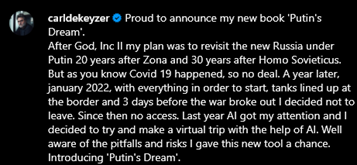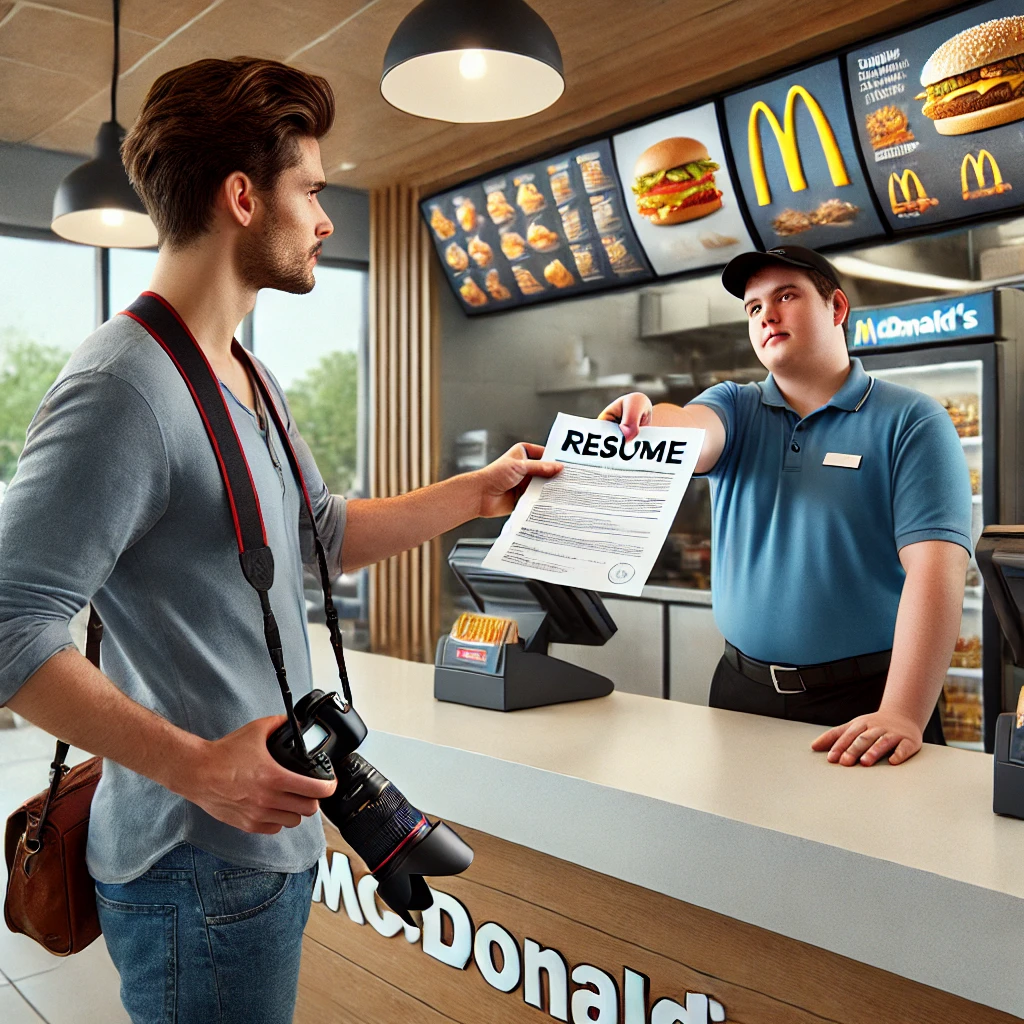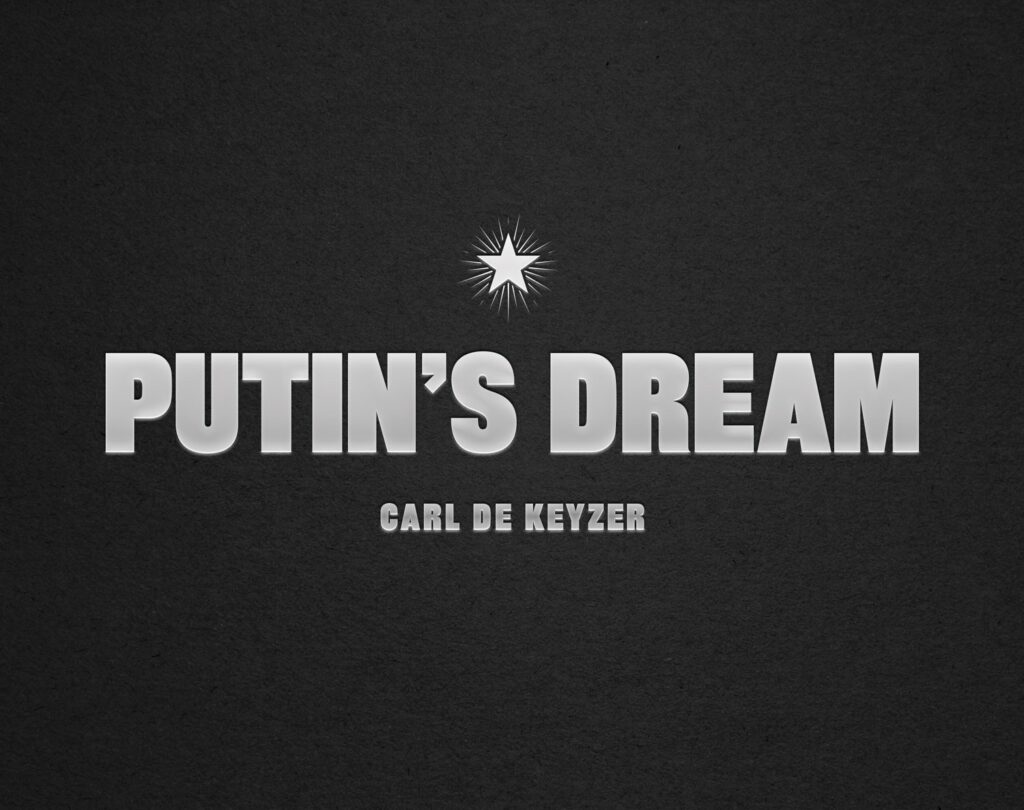This article proposes to look at AI-generated images in a positive light by considering them as an enhancer of the value that “images of the real” possess. I will start by discussing Magnum photographer Carl de Keyzer’s new AI-generated images book project, before proposing a definition of a photographic image that allows to undermine AI-generated images by describing a value that applies exclusively to “real images”.
Last year, renowned Magnum photographer Carl de Keyzer announced the release of a new book focusing on Russia: “Putin’s dream”. What could have been exciting news for the photography world; the release of a new book focusing on the subject about which the photographer released some of its most acclaimed work (Homo Sovieticus in 1989 and Zona in 2003), quickly turned into a backlash with the photography community taking heated stances. The reason for that? The magnum photographer’s book only contains AI-generated images.
Top: Some photos from Homo Sovieticus (1989) Bottom: Some photos from Zona (2003)
The photojournalist (or should we now refer to him as a visual artist since by this release, he goes beyond, or perhaps below, photography?) described the work on his Instagram profile in the following way:

The negative reactions in the comments, which led to the post being deleted, mostly focused on the visual artist’s glorious past at Magnum, outlining that such a photographer should not be allowed to produce AI work because by doing so he gives credibility to a tool considered as evil by many photographers… I believe that anyone should be able to create what they want, and that the audience has the right to their own opinion and to its expression. From the excerpt I had seen, I also initially believed that this book was garbage and a terrible attempt at using AI artistically and documentarily. I believed that for reasons that differed from the simple use of AI which was the main focus of the general public’s criticism. I will explain why I initially believed this project was bad later and how I changed my mind, but for now, let’s take a step back and discuss AI and its relationship with photography and photographers.
The pace and the apparent exponentiality with which AI image generation products are evolving was welcomed with distrust, fear and hate by a vast majority of photography practitioners. The goal of this article is not to minimize the massive societal changes that result from these technologies but rather to discuss the position streetphotographers and documentary photographers (I will call them photographers of the real in this article) should take with regards to them, and as you will see, what was first perceived as a threat can be used as a tool to underline the great value that “images of the real” are carrying.
First of all, let me admit that for other genres of photography, and more particularly the ones in which the physical reality that is photographed does not have a significant role to play in the value of the photographs, the future seems dull. I am talking here mostly of product photography, corporate headshots and generally most of studio photography (especially in cases in which the end goal is commercial). If your living relies on these types of images, I would advise you to start handing your CVs to your local fast food restaurant. But will “photographers of the real” also need to flip burgers for a living due to the raise of AI? Well… most of them already flip burgers or spend the day in front of excel to afford to survive so not much will change. But we can ask ourselves if it will still be worth it for “photographers of the real” to go out in the streets to get their shots, often facing negative reactions, when typing a few words in an AI generating machine will end up in results that might look better and that are achievable faster. And if it’s still worth it, why?

What the future looks like for product photographers
From all the reactions “photographers of the real” can have when realizing the power of AI image generation tools, the easiest one, distrust, is justified by the fact that AI images can be easily mistaken for genuine ones by the general public and probably soon by the photography experts too. This distrust is not the right reaction. Although AI images may be perceived as genuine photographs, they simply aren’t photographs. As soon as the street and documentary photography community manages to maintain a distinction between AI images and actual photographs, no threat is caused.
There must be a high degree of vigilance aiming to spot AI-generated images, similar, perhaps stricter and more formally organized than the vigilance there is around images which content is altered with photoshop or simply staged (and I can say with confidence that some “streetphotographers” are staging their shots, sometimes winning awards). This vigilance can be maintained by “photographers of the real’s” filtering, the creation of a seal of authenticity or of an oath, and by throwing onto the pyre the “photographers” that are caught trying to make their AI creations pass as real. As soon as there are successful efforts in distinguishing images of the real from AI-generated images, I believe that AI-generated images will not lead to the reduction of the interest nor to the extinction of street and documentary photography.
The positive point I want to outline in that article is that this feeling of distrust and fear towards AI-generated images can easily be compensated by a feeling of joy when considering the relative power AI images give to street and documentary photography and which will maintain the interest one can take to go out to shoot and the interest one can take to look at images (perhaps even more than before AI tools).
To understand how street and documentary photography, as an art form, can survive the AI tsunami and how AI images might empower “images of the real”, one must look at the value of the latter and specifically at the value that an “image of the real” has, that an AI-generated image hasn’t.
To find this distinguishing value, we must investigate what are the different values attached to “images of the real”, in other words, what are the properties that a successful “image of the real” has that makes us cherish it? The most evident one, is aesthetic value, but this is not a value that will differentiate it from an AI generated image, as the latter can also be perfect aesthetically speaking, especially if we judge its beauty while being free from framing effects.
Some street and documentary photography have an epistemic value in the sense that they teach us something. To take obvious examples, streetphotography can teach us how the streets looked at a certain point in time, how people dressed, or that a singular character was strolling through the streets of a certain city and documentary photography can give us even deeper epistemic insights, etc.
But this epistemic value is also not sufficient in defending “photography of the real” from the AI threat as it excludes some of its subgenres that do not carry any epistemic value. One of the excluded subgenre is abstract photography. A lot of streetphotography geniuses engage in (some) abstract images that do not teach us anything but that carry a certain value and that combined with other images can take a broader sense.
If we want to provide a rationale that maintains streetphotography’s importance in the age of AI generated images, we must therefore find a value that goes beyond the values discussed above. A value that is specific to “photography of the real”.
I believe that there is a value that fits the bill. This value is simply derived from the fact that reality plays a fundamental role in the photographic image. Photography of the real, as its name indicates it, has a fundamental relationship with reality, from which it extracts fragments of reality. To theorize this value, we must first define the photographic image.
Once, among the millions of thoughts that constantly fuse through my hyperactive brain (this is not a flex, more a confidence about one of my many flaws), I came up with the following definition for a photographic image. I believe the definition you are about to discover is not only the best definition ever made, but also the most promising one with regards to its derivative explanatory power (this is a flex).
Here is this definition:
“A photographic image is the result of a relationship between a physical reality, a device used to visually record this physical reality in a single frame, and a photographer, present in that physical reality, operating the said device.”
This way of describing the photographic image as the result of a relationship allows us to say that the nature of this relationship plays an important role in the value of the image. What a specific photographer makes out of a specific physical reality, how they carve something out of a precise temporality and physical reality, and how they freeze it into a single frame are perhaps more important than any epistemic or aesthetic value. This “relational value” is what distinguishes the photographer of the real from the AI nerd.
This value is the one that AI-generated images and their blandness do not possess. It is thanks to this relational value that we are impressed by an image. We are impressed by the relationship a photographer had at a precise point in time with the physical reality that he was evolving in. This relationship is even more impressive in “photography of the real”, as in this overarching genre, the physical reality one evolves in is often fast paced, making it harder to sculpt something meaningful out of it. For this reason, among others, I believe that “photography of the real”, a term that I did not define clearly yet, is the highest form photography can take. A form that transcends all other visual arts thanks to the fact that it is based on this extremely tight relationship with reality.
To simplify this explanation: there is a value in the photographic image being the result of the relationship between a physical reality, a photographer present in that physical reality and a camera used to capture it. In “images of the real”, the physical reality that is captured and the fact that the image was the result of the abovementioned relationship plays a major role in the value ascribed to the image.
That is the reason why I titled this article like this. AI-generated images are not a threat to “photography of the real”, they help underline its beauty, its perks and its hegemony in the photography field. AI-generated images, when trying to pass as photographs of the real, are lacking a fundamental value which means that they will never be equal to genuine photographs. You can keep shooting, and you can keep mocking “AI-streetphotographers”.
In more commercially oriented genres, and generally in genres in which the photograph is staged, this value does not really apply, because the physical reality is not left untouched, which makes it easier or sometimes unavoidable to catch that infamous decisive moment. In my opinion, it is even a good thing if images in this category can be made in a faster way thanks to the use of AI technologies.
Let’s now get back to Carl de Keyzer’s book project. Its problem, and the reason why I believed it was a bad book is now obvious: the lack of the relational value discussed above. Carl de Keyzer’s images are lacking a physical reality and a tool used to capture it, and I had the impression that no other values were compensating for this issue. I also believed that it was grotesque in the way it was presented, technically not well done, and lacking subtlety in the message. It simply looked to me like it was a low effort project, made by a boomer who was amazed by his discovery of image generating tools.

Despite deleting the instagram post announcing it, the book is on sale on Carl de Keyzer’s website.
My idea changed as I was about to publish this article, which included harsh criticism of “Putin’s Dream” (based on the excerpt of the book). I went to the great photography bookstore “La Chambre Noire” in Lausanne and as I entered, I was surprised to see that the book I was discussing in this article was sitting on the shopkeeper’s desk. This was a happy coincidence as a few days before, I started feeling bad about posting harsh criticism of a project I hadn’t seen in its entirety.
Seeing the book made me reconsider my judgement because I noticed that I had treated this book as a photography book. I made the same mistake as the instagram horde criticizing and sometimes even insulting the photographer. This is not photography. It is not a photography book. It is an art project, using some of the codes of photography, aiming to imagine what a documentary photographer could photograph in the Russia Putin dreams off. And this is exactly the kind of projects that AI technologies allow, in which artists are able to show possible worlds.
Scrolling through the book I noticed a lot of humour, a certain coherence between the images, some depicting happy grandparents in the country side, others showing oligarchs. It looked at the same time like a caricature and like photos that could be used for propaganda purposes. The naivety in which AI is used accentuates this propaganda look as most of the images are easy to detect as not being real. Their kitschness also participates in giving them this propaganda look, making this project more satirical than I first envisioned it. The lack of the relational value that we can find in photographs is not even an issue as this, once again, is not a photography book. It possesses other values, such as the fact to be future-oriented, enabling a reflection of what the future should look like, what it risks to look like, and how we can avoid it looking in a way we do not want it to look.
I had never been fundamentally against the artistic use of AI technologies and was quite impressed by some AI projects in the past. I invite any photographer that was initially shocked by Carl De Keyzer’s project to try to look at AI works with an open mind, not considering them as photographic works but as artworks belonging to another category. One project that helped me open my mind to the use of AI in the art field and that particularly struck me was the project “New Farmers” by Bruce Eesly. In this project, the artist reimagined the green revolution, and what would have happened if, instead of maximizing the productivity of vegetable species, we maximized their size. The project offered a subtle criticism of the controversial project of modifying vegetal species to increase their productivity through a clever use of AI aiming to show possible worlds. By using AI to create images that are comic due to their absurdity, Eesly underlines the absurdity of an existing issue. In this case, the conceptual message conveyed by the artist, and his ability to make us think about an issue through absurdity is successful to the point that the missing relational values is compensated by other values which still lead to an artwork I can find interesting.
Some images from the “New Farmer” project by Bruce Eesly.
A valid criticism that is more subtle than the AI bashing is to refuse that funds supposed to be allocated to photographic works become allocated to AI works instead, which is what happened with the Bruce Eesly exhibition I mention above. A festival of visual arts can include both, I would expect a festival of photography to limit itself quite strictly to photographic works.
To conclude this article, I would say that AI is a good thing for photography, as it helps go back to what should be its motto, freezing unaltered reality, while chopping off what are its vices, the commercial use of images capturing a staged reality.
If you have liked this article and want to read more opinion pieces, book reviews and informative articles, please subscribe to my newsletter. Remember that you are reading this on a website. No algorithm will suggest it to your friends, if you believe it was an interesting read, I would be grateful if you share it. You can also comment this article if you have any observations to make. I am trying to make this blog an interactive place but this is only possible if readers take an active role!
